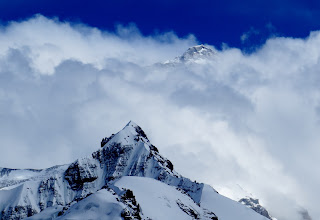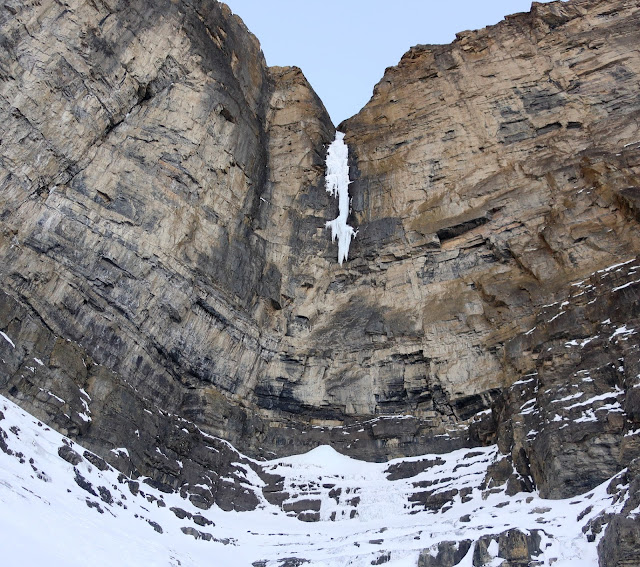Himalayan snapshots
The last time I wrote a post for this blog, I was on a 13-hour flight from Vancouver to Guangzhou, the second of the three flights taking me from Calgary to Kathmandu. A great deal happened since then, most of it unexpected. Was the Nepal earthquake a black swan event? Or was it merely an instance of Russell's turkey? I suppose it's a matter of perspective.
I wrote about my experiences on the north side of Everest on my sponsors' blogs. For raw impressions of our expedition as it first unfolded and then folded, check out the blogs of Arc'teryx (instalments 1, 2, 3 and 4), Black Diamond (instalments 1 and 2) and Scarpa (instalments 1, 2, 3 and 4). I didn't feel I had much to add to what I wrote there, so rather than repeat myself I thought I would relive the trip through images. I didn't find the experience I was looking for in Tibet, but I lived through the one nature dished out. I am one of the lucky ones: I still have a future to dream about.
Everest from Chinese Basecamp. In spite of its chequered reputation, in the end Everest's still just a big, beautiful mountain. Like on other sought-after peaks such as Denali, while normal routes might be crowded, when you step off the beaten track you can find all the solitude and adventure you could wish for.
David Gottler and...
... Daniel Bartsch, my partners for our proposed alpine-style attempt on a new route, sipping espressos in Kathmandu's Thamel district. It felt strange to go on a big trip with two people I'd never met before. More than anything, it was the jokes that flew back and forth in countless emails that convinced me we'd make a good team. And we did.
Before leaving Kathmandu, we sought blessing from a lama. The three of us knelt before him while he uttered incantations and tapped our bowed heads in an elaborate ritual. He didn't take long with Daniel and David but took his time with me. I never did find out why.
The svastika, a thousands-years-old symbol of good luck in several Eastern traditions, on a Nepalese truck.
When we first crossed into Tibet, I didn't quite know what to expect. I was mortified when a Chinese border guard dug out a khata from my pack. Somewhat to my surprise, he let me go. Later, I realized that Chinese authorities are fairly tolerant of Buddhist symbols and practices - so long as they remain safely apolitical.
Four days out of Kathmandu, we drove over a 5000-metre pass. It was the fastest I ever went from thick to thin air. Fortunately, other than the occasional stop to stretch our legs, we didn't have to exert ourselves.
Tibetan towns are full of dogs. Theirs isn't an easy existence, wandering the streets looking for scraps of food. At least they have thick fur and each other to keep warm on the cold high steppes of central Asia.
Late in the afternoon on our second day in the town of Tingri, the skies cleared. There, high above the brown plains with their herds of sheep and goats, rose the snowy Himalaya. Cho Oyu is on the right; Everest is the pyramidal peak on the left.
The following day we drove over more high passes on a bumpy dirt track. Everest disappeared behind intervening ridges. When we saw it again, its huge bulk filled the southern horizon.
A few kilometres down from basecamp is the "old" Rongbuk monastery, a cluster of buildings and caves where monks have lived and meditated since the 1700s (the "new" monastery further down valley was founded in 1902). When I first stepped into the candle-filled cavern, I rushed straight back out: between the 5000-metre altitude and hundreds of burning candles, it felt like there was no oxygen left to breathe. Once my heart slowed down I eased back inside, knowing now what to expect.
After a few minutes my eyes adjusted to the dim light. It was then that I spotted a cat napping in a corner of the cave. In spite - or perhaps because - of being oxygen deprived, it looked supremely content.
Speaking of oxygen, on this trip even more than on any other Himalayan expedition, we needed to take our time acclimatizing. Instead of following the yak trail to the 20-kilometre-distant advanced basecamp, we spent our days hiking up a talus-covered ridge directly above basecamp. There, just a couple of hours from camp, we could pitch a tent at nearly 6000 metres and begin the arduous process of getting used to functioning in air containing less than half the oxygen we breathed at home.
We scrambled up the nearest peak, a rounded 6300-metre hump. The shattered limestone rubble near the top reminded me of my beloved Rockies. It was strange to think that we were in fact higher than the summit of Denali. We didn't yet know it would be the highest point we would reach on the trip. Photo: David Gottler.
From our modest summit, we gazed across at Everest, still more than two and a half kilometres higher. We knew that our plan for climbing a new route in alpine style was a long shot. All the same, as we grew more comfortable in the thin air, we felt anxious yet optimistic about the coming weeks.
It was while we were resting back down in basecamp after one such outing that the earthquake struck. Luckily camp is in the middle of a stony plain, with nothing worse than rubbly hillsides rising above it. After the initial shock passed and we realized we were likely safe where we camped, our thoughts turned to the south side of the mountain and to the deep valleys of the Khumbu. The sometimes confused news arriving from Nepal during the coming hours and days proved worse than our worst fears.
To begin with, we thought about going to Kathmandu and helping in any way we could. Then, once we realized we would be worse than useless there, we considered going on with the expedition. However, after a few days' hesitation, the China Tibet Mountaineering Association decided to close the big peaks of Tibet to climbing.
On our last full day in basecamp, we wandered up the rubble of the Rongbuk Glacier toward the north face of Everest. It was a cloudless, shining, windless day. The distant icefields and couloirs glistened in the sun. I knew it was selfish of me, with the tens of thousands of tragedies unfolding in Nepal, but I couldn't help feeling disappointed our expedition ended before it had truly began.
The next morning, our cook Sitaram smiled as he bid us farewell, even though back in Kathmandu his family slept out in the streets, too scared to go back inside their damaged house. What was thwarted ambition next to lives that would take months, even years to rebuild - if they could be rebuilt at all?
Less than two days later we were in Lhasa, playing at being tourists, taking pictures of the Potala palace with a red Chinese flag flying above it. Everest and all that happened there was already receding into the past, a past remembered but no longer experienced.
Lhasa is a strange mix of the old and the new, of Tibetan tradition and Chinese development. The two appear to coexist peacefully, though SWAT teams in their black uniforms lounging in the corners of temple squares say otherwise.
We wandered through the city getting haircuts, dining on an eclectic mix of Chinese, Tibetan and Nepalese food, playing street pool.... In another day we would go our separate ways, the whole strange trip but a memory.

























Comments
Post a Comment